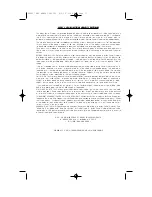
3
IMPORTANT SAFETY INSTRUCTIONS
WARNING:
Warning statements identify conditions or practices that may result in
personal injury or loss of life.
W
W
W
WAAAARRRRNNNNIIIINNNNGG
G
G:::: RRRRIIIISSSSKKKK O
O
O
OFFFF EEEEXXXXPPPPLLLLO
O
O
OSSSSIIIIVVVVEEEE GG
G
GAAAASSSSEEEESSSS
Working in the vicinity of a lead acid battery is dangerous. Batteries generate
explosive gases during normal battery operation, for this reason, it is of utmost
importance that each time before using the jump starter, you read this manual
and follow the instructions exactly.
1. When working with lead acid batteries, always make sure immediate
assistance is available in case of accident or emergency.
2. Always use protective eyewear when using this product: contact with battery
acid may cause blindness and/or severe burns, be aware of first aid
procedures in case of accidental contact with battery acid.
3. There is a risk of releasing explosive gases when lead acid batteries are
charged or discharged. Failure to follow instructions may cause property
damage, explosive hazard, and/or personal injury.
4. When connecting the battery clamps to a discharged battery and an alarm
sounds - the clamp connections are incorrect and need to be reversed.
5. Jump-start procedures should only be performed in a safe, dry, well-
ventilated area.
6. Always store battery clamps on clamp tabs when not in use. Never touch
battery clamps together. This can cause dangerous sparks, power arcing
and/or explosion.
7. When using this unit close to the vehicle’s battery and engine, stand the unit
on a flat, stable surface, and be sure to keep all clamps, cords, clothing and
body parts away from moving vehicle parts.
8. Do not wear vinyl clothing when jump-starting a vehicle, friction can cause
dangerous static-electrical sparks. Remove all jewelry or metal objects that
could cause short circuits or react with battery acid.
9. Always disconnect the negative (Black) jumper cable first, followed by the
positive (Red) jumper cable, except for positive ground systems.
10. Never allow red and black clamps to touch each other or another common metal
conductor–this could cause damage to the unit and/or create sparking/explosion
hazard. Always store battery clamps on built-in clamp tabs when not in use.
11. Do not expose battery to fire or intense heat since it may explode. Before
disposing of the battery, protect exposed terminals with heavy-duty electrical
tape to prevent shorting (shorting can result in injury or fire).
12. Do not smoke or use flammable items (matches, cigarette lighters, etc.) while
working on a vehicle’s battery system.
13. Whether stored, or in use, keep unit out of reach of children.
14. Do not operate charger in rain or snow, nor use when wet.
15. Never charge a frozen battery.
16. When using an extension cord, make sure it has the same configuration as
the plug of the Power System and that the cord is properly wired and in good
electrical condition. This cord needs to be suitable for 120 VAC and 250 AC
milliamperes.
17. Place Power System as far away from the battery as DC cables permit.
18. Never allow battery acid to come in contact with the Power System.
19. Do not operate Power System in a closed area or restrict ventilation in any
way.
SAVE THESE INSTRUCTIONS.
HSK037 ENG MANUAL 090105 9/1/05 5:48 PM Page 3



































